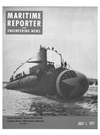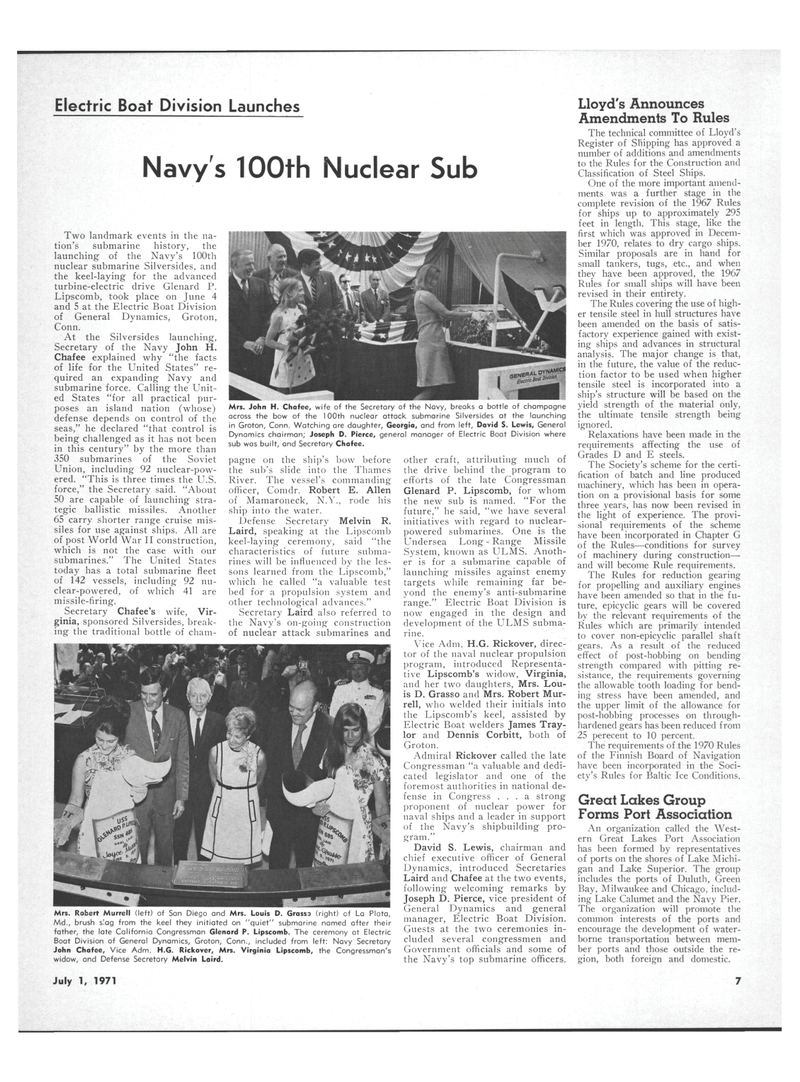
Page 1: of Maritime Reporter Magazine (July 1971)
Read this page in Pdf, Flash or Html5 edition of July 1971 Maritime Reporter Magazine
Electric Boat Division Launches
Navy's 100th Nuclear Sub
Lloyd's Announces
Amendments To Rules
The technical committee of Lloyd's
Register of Shipping has approved a number of additions and amendments to the Rules for the Construction and
Classification of Steel Ships.
One of the more important amend- ments was a further stage in the complete revision of the 1967 Rules for ships up to approximately 295 feet in length. This stage, like the first which was approved in Decem- ber 1970, relates to dry cargo ships.
Similar proposals are in hand for small tankers, tugs, etc., and when they have been approved, the 1967
Rules for small ships will have been revised in their entirety.
The Rules covering the use of high- er tensile steel in hull structures have been amended on the basis of satis- factory experience gained with exist- ing ships and advances in structural analysis. The major change is that, in the future, the value of the reduc- tion factor to be used when higher tensile steel is incorporated into a ship's structure will be based on the yield strength of the material only, the ultimate tensile strength being ignored.
Relaxations have been made in the requirements affecting the use of
Grades D and E steels.
The Society's scheme for the certi- fication of batch and line produced machinery, which has been in opera- tion on a provisional basis for some three years, has now been revised in the light of experience. The provi- sional requirements of the scheme have been incorporated in Chapter G of the Rules—conditions for survey of machinery during construction— and will become Rule requirements.
The Rules for reduction gearing for propelling and auxiliary engines have been amended so that in the fu- ture, epicyclic gears will be covered by the relevant requirements of the
Rules which are primarily intended to cover non-epicyclic parallel shaft gears. As a result of the reduced effect of post-hobbing on bending strength compared with pitting re- sistance, the requirements governing the allowable tooth loading for bend- ing stress have been amended, and the upper limit of the allowance for post-hobbing processes on through- hardened gears has been reduced from 25 perecent to 10 percent.
The requirements of the 1970 Rules of the Finnish Board of Navigation have been incorporated in the Soci- ety's Rules for Baltic Ice Conditions.
Great Lakes Group
Forms Port Association
An organization called the West- ern Great Lakes Port Association has been formed by representatives of ports on the shores of Lake Michi- gan and Lake Superior. The group includes the ports of Duluth, Green
Bay, Milwaukee and Chicago, includ- ing Lake Calumet and the Navy Pier.
The organization will promote the common interests of the ports and encourage the development of water- borne transportation between mem- ber ports and those outside the re- gion, both foreign and domestic.
Two landmark events in the na- tion's submarine history, the launching of the Navy's 100th nuclear submarine Silversides, and the keel-laying for the advanced turbine-electric drive Glenard P.
Lipscomb, took place on June 4 and 5 at the Electric Boat Division of General Dynamics, Groton,
Conn.
At the Silversides launching,
Secretary of the Navy John H.
Chafee explained why "the facts of life for the United States" re- quired an expanding Navy and submarine force. Calling the Unit- ed States "for all practical pur- poses an island nation (whose) defense depends on control of the seas," he declared "that control is being challenged as it has not been in this century" by the more than 350 submarines of the Soviet
Union, including 92 nuclear-pow- ered. "This is three times the U.S. force," the Secretary said. "About 50 are capable of launching stra- tegic ballistic missiles. Another 65 carry shorter range cruise mis- siles for use against ships. All are of post World War II construction, which is not the case with our submarines." The United States today has a total submarine fleet of 142 vessels, including 92 nu- clear-powered, of which 41 are missile-firing.
Secretary Chafee's wife, Vir- ginia, sponsored Silversides, break- ing the traditional bottle of cham-
Mrs. John H. Chafee, wife of the Secretary of the Navy, breaks a bottle of champagne across the bow of the 100th nuclear attack submarine Silversides at the launching in Groton, Conn. Watching are daughter, Georgia, and from left, David S. Lewis, General
Dynamics chairman; Joseph D. Pierce, general manager of Electric Boat Division where sub was built, and Secretary Chafee. pagne on the ship's bow before the sub's slide into the Thames
River. The vessel's commanding officer, Comdr. Robert E. Allen of Mamaroneck, N.Y., rode his ship into the water.
Defense Secretary Melvin R.
Laird, speaking at the Lipscomb keel-laying ceremony, said "the characteristics of future subma- rines will be influenced by the les- sons learned from the Lipscomb," which he called "a valuable test bed for a propulsion system and other technological advances."
Secretary Laird also referred to the Navy's on-going construction of nuclear attack submarines and
Mrs. Robert Murrell (left) of Son Diego and Mrs. Louis D. Grass? (right) of La Plata,
Md., brush s!ag from the keel they initiated on "quiet" submarine named after their father, the late California Congressman Glenard P. Lipscomb. The ceremony at Electric
Boat Division of General Dynamics, Groton, Conn., included from left: Navy Secretary
John Chafee, Vice Adm. H.G. Rickover, Mrs. Virginia Lipscomb, the Congressman's widow, and Defense Secretary Melvin Laird. other craft, attributing much of the drive behind the program to efforts of the late Congressman
Glenard P. Lipscomb, for whom the new sub is named. "For the future," he said, "we have several initiatives with regard to nuclear- powered submarines. One is the
Undersea Long - Range Missile
System, known as ULMS. Anoth- er is for a submarine capable of launching missiles against enemy targets while remaining far be- yond the enemy's anti-submarine range." Electric Boat Division is now engaged in the design and development of the ULMS subma- rine.
Vice Adm. H.G. Rickover, direc- tor of the naval nuclear propulsion program, introduced Representa- tive Lipscomb's widow, Virginia, and her two daughters, Mrs. Lou- is D. Grasso and Mrs. Robert Mur- rell, who welded their initials into the Lipscomb's keel, assisted by
Electric Boat welders James Tray- lor and Dennis Corbitt, both of
Groton.
Admiral Rickover called the late
Congressman "a valuable and dedi- cated legislator and one of the foremost authorities in national de- fense in Congress ... a strong proponent of nuclear power for naval ships and a leader in support of the Navy's shipbuilding pro- gram."
David S. Lewis, chairman and chief executive officer of General
Dynamics, introduced Secretaries
Laird and Chafee at the two events, following welcoming remarks by
Joseph D. Pierce, vice president of
General Dynamics and general manager, Electric Boat Division.
Guests at the two ceremonies in- cluded several congressmen and
Government officials and some of the Navy's top submarine officers.
July 1, 1971 7

 2nd Cover
2nd Cover

 2
2
